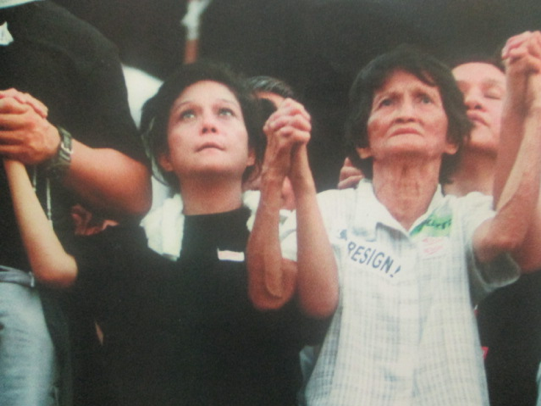
Suffering as a Function of Stardom
In Patrick Flores’s The Star Also Suffers: Screening Nora Aunor (2001), he describes confessional performance as being a simultaneous unburdening of the self and burdening of others with one’s pain, a transaction wherein ‘pain serves both as labor and capital of the struggle of a human agent […] to bear witness and testify, to make the necessary sacrifice of putting herself at risk and in a position of vulnerability and exposure to consumption and compassion’1. Flores is describing actress-turned-politician Nora Aunor confessing at the EDSA Dos rally in 2001 that she had suffered abuse at the hands of her long-time political ally, ex-lover, ex-costar (and ex-President of the Philippines), Joseph ‘Erap’ Estrada. The confession is aired on national news outlets.
In the footage, Nora is pictured standing at EDSA Shrine in a plain black t-shirt (the official color of the EDSA Dos revolution) with a Good Morning towel draped over her shoulders.

Nora Aunor at EDSA Dos, hand-in-hand with Urban Poor Rights activist, Carmen “Nanay Mameng” Deunida
Her eyes are turned heavenwards and she is photographed hand-in-hand with Urban Poor Rights activist Carmen ‘Nanay Mameng’ Deunida2. EDSA Shrine is a place associated with both revolution and reverence. From the photo and video coverage, the Filipino (or at least Manilenyo) mind was free to assume that she was looking up at the monument of Mary, Queen of Peace. Her confession being documented this way holds cultural weight. Nora Aunor was the first non-mestizaje actress to make it big on the silver screen in the early sixties, allowing Filipinos to see their stories enacted by someone who looked like them: brown-skinned with a small nose, not approximating any Hollywood counterparts3.

Nora Aunor in Himala (1982).
Nora’s most famous films, Atsay (1978), Himala (1982), and The Flor Contemplacion Story (1995), have nationalistic leanings. They problematise themes like the fanatic nature of worship in religious communities and abuse domestic workers and Overseas Filipino Workers or OFWs are exposed to. Noranians4 are from diverse backgrounds: from academics and film critics, to doctors and lawyers, to grandmothers and aunties in the province.
As a result, most Filipino audiences have seen Nora in this pose before. Those of us who are familiar with her body of work know that this look heralds emotional upheaval, catharsis, and an oncoming monologue. Flores describes this confession as emotional but also strategic: a way to signal that Nora was shifting allegiances, an act which would put her back in the public’s good graces at a time when Erap was almost surely going to be impeached.
This passage from The Star Also Suffers: Screening Nora Aunor was one of the first I bookmarked and copy-pasted onto a Notion Table that would grow to contain nearly a hundred passages in the span of the eight months it took me to complete my masteral thesis, Functions:Poems, a collection of thirty-one poems (forthcoming from Grana Books in 2024) which borrow their form from trigonometric functions and their images from three of Nora’s Guy & Pip romantic comedies5. From the get-go, I knew I wanted my project to explore pain as a function of romance, but this quotation steered me toward its then-unarticulated crux: female labor.
Like Nora’s confession, the more personal my attachment to this endeavour of articulation became, the more political it became as well; the more emotional its core grew, the more strategic the choice to write it seemed to be. On the one hand, I, too, wanted to confess: to say this happened to me and it was terrible and I want you all to care and ache and never be the same – on the other, I also wanted the confession to be about the labor young Filipina women are subjected to in relationships, in media, in the public eye, on the internet. I wanted this collection to be a showcase of craft informed by context, of the ability to distill what it would mean for these forms of suffering and stardom to happen to people who look like me (brown, short, curvy, undeniably and obviously Filipina) into a suit of poems that was aloof enough to be taken seriously, but coy enough to have sex appeal.
I wanted to write a poetry collection that unabashedly romanticised the Maldita-centric melodrama of Filipino cinema. I wanted the persona to possess both the cold-blooded rage of the bitch paying her son’s hampas-lupa6 girlfriend ten million pesos to stay away and the earnestness of the virginal leading lady who is unwaveringly hopeful and will do anything for love, for family, for country.
- See The Star Also Suffers: Screening Nora Aunor by Patrick Flores. ↩
- Photo is from a citizen archive on EDSA Dos, documented by a then-16-year-old Michael Charleston “Xiao” B. Chua from Tarlac. ↩
- See Sharon’s Noranian Turn: Stardom, Embodiment, and Language in Philippine Cinema by Bliss Cua Lim for more information on mestizaje culture in Filipino cinema, Nora’s career and impact. ↩
- Persons who identify as avid fans and supporters of Nora Aunor and her body of work. ↩
- ‘Guy & Pip’, the first film starring Nora Aunor and Tirso Cruz III, which later became the name of their ‘love team’ or pairing which would persist for 14 movies. ↩
- A derogatory Tagalog term often used in Teleseryes and pinoy movies to describe someone deprived of dignity due to extreme poverty; hampas literally means ‘to strike’ while lupa means ‘earth’ or ‘dirt’. ↩













